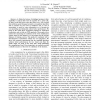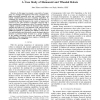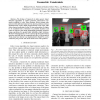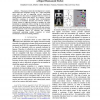IROS
2007
IEEE
14 years 5 months ago
2007
IEEE
IROS
2007
IEEE
14 years 5 months ago
2007
IEEE
Abstract— In this paper we present a case study of cooperation of a strongly heterogeneous robot team, composed of a highly articulated humanoid robot and a wheeled robot with la...
IROS
2007
IEEE
14 years 5 months ago
2007
IEEE
—The F2 (Force Field) method is a novel approach for multi-robot motion planning and collision avoidance. The setting of parameters is however vital to its performance. This pape...
IROS
2007
IEEE
14 years 5 months ago
2007
IEEE
— We present a novel algorithm for motion planning of multiple robots amongst dynamic obstacles. Our approach is based on a new roadmap representation that uses deformable links ...
IROS
2007
IEEE
14 years 5 months ago
2007
IEEE
— We develop a framework to allow generic object detection algorithms to exploit geometric information commonly available to robot vision systems. Robot systems take pictures wit...
IROS
2007
IEEE
14 years 5 months ago
2007
IEEE
Abstract— We address the problem of determining and obtaining the visibility of a moving target from multiple angles using a mobile robot. The pursuer uses a modified form of pu...
IROS
2007
IEEE
14 years 5 months ago
2007
IEEE
Abstract— Tactile telepresence has been expected to be technology which encourages operators of robotic systems to remotely maneuver objects or recognize materials being touched ...
IROS
2007
IEEE
14 years 5 months ago
2007
IEEE
— In this paper, we studied how a mobile robot equipped with a 3D laser scanner can start from primitive behaviors and learn to use them to achieve goal-directed behaviors. For t...
IROS
2007
IEEE
14 years 5 months ago
2007
IEEE
— This paper presents the development of a contact interaction-based navigation strategy for a biped humanoid robot with the aim of supporting current visual-based navigation. Th...
IROS
2007
IEEE
14 years 5 months ago
2007
IEEE
— We present in this article a simple method to estimate an IPM view from an embedded camera. The method is based on the tracking of the road markers assuming that the road is lo...




